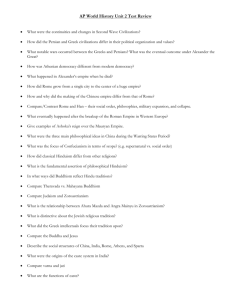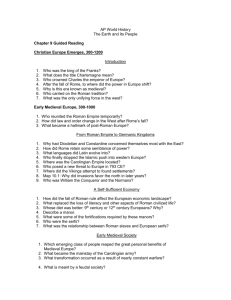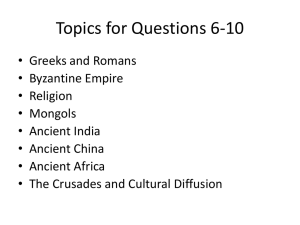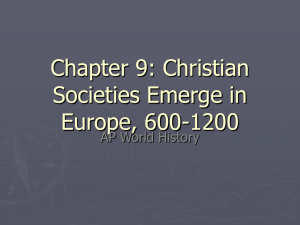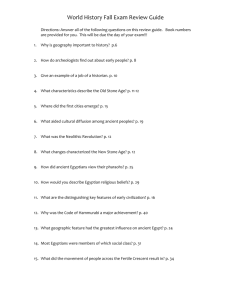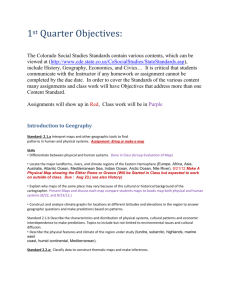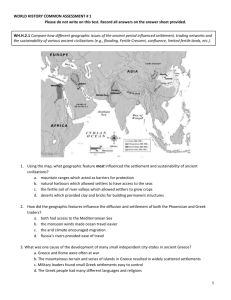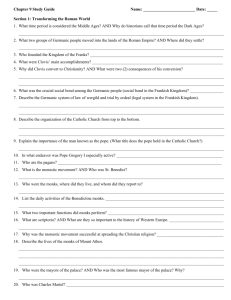Global I Review - Marlboro Central School District
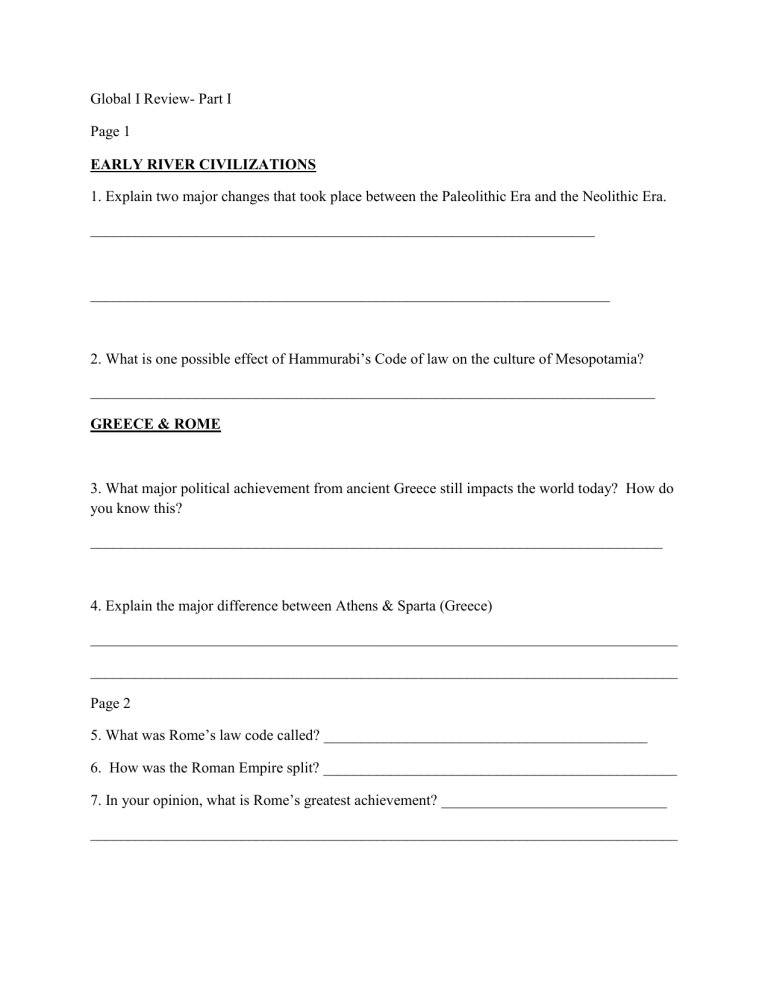
Global I Review- Part I
Page 1
EARLY RIVER CIVILIZATIONS
1. Explain two major changes that took place between the Paleolithic Era and the Neolithic Era.
___________________________________________________________________
_____________________________________________________________________
2. What is one possible effect of Hammurabi’s Code of law on the culture of Mesopotamia?
___________________________________________________________________________
GREECE & ROME
3. What major political achievement from ancient Greece still impacts the world today? How do you know this?
____________________________________________________________________________
4. Explain the major difference between Athens & Sparta (Greece)
______________________________________________________________________________
______________________________________________________________________________
Page 2
5. What was Rome’s law code called? ___________________________________________
6. How was the Roman Empire split? _______________________________________________
7. In your opinion, what is Rome’s greatest achievement? ______________________________
______________________________________________________________________________
BELIEF SYSTEMS
8. What are two similarities between Judaism, Christianity, and Islam?
______________________________________________________________________________
______________________________________________________________________________
9. What is the ultimate goal for Buddhists?
__________________________________________________________________________
10. What is the ultimate goal for Hindus?
_____________________________________________________________________________
11. List three key terms associated with Buddhism
__________________
__________________
__________________
12. List three key terms associated with Hinduism
___________________
___________________
___________________
13. What is the major difference between Hinduism and Buddhism?
______________________________________________________________________________
Page 3
14. What is the goal of the FIVE RELATIONSHIPS associated with Confucianism?
_____________________________________________________________________________
15. Where is Confucianism practiced? ______________________________________
16. What is one similarity between the two major Chinese belief systems, Confucianism &
Daoism?
______________________________________________________________________________
EALRY INDIA
17. Why do most historians agree that India experienced a Golden Age during the GUPTA
EMPIRE?
______________________________________________________________________________
18. What argument can you make that not everyone experienced a Golden Age during the
GUPTA EMPIRE?
______________________________________________________________________________
BYZANTINE EMPIRE
19. List four key terms associated with the Byzantine Empire
________________________, _____________________, ______________________,
________________________________
20. What religion was practiced heavily throughout the Byzantine Empire?
_____________________________________
THE MIDDLE AGES & THE CRUSADES
21. Why did people in Europe need protection during the Middle Ages (a.k.a. the Dark Ages,
The Medieval Period)
______________________________________________________________________________
22. Define FEUDALISM: ________________________________________________________
23. What did serfs provide on the manor? ___________________________________________
Page 4
24. Who was at the top of the European feudal hierarchy? _______________________________
25. What was the most important part of the lives of Medieval Europeans?
___________________________________________
26. What was the major cause of the CRUSADES?
______________________________________________________________________________
27. How did the Crusades affect Europe negatively?
______________________________________________________________________________
28. How did the Crusades affect Europe positively?
______________________________________________________________________________
Part II- Essay Practice
Directions: Use pp. 5-10 to complete the thematic essay outlines
Non-political revolutions: The Renaissance, The
Reformation, The Age of Exploration, The
Enlightenment
Migration of goods/people: The Age of
Exploration
Conflicts that threatened peace: The French
Revolution
Leaders/Ideas: Peter the Great, Catherine the Great
Multiple Choice Practice
1. One reason for the development of an early civilization in the Tigris-Euphrates river valleys was that
1.
the location protected the people from land invasion
2.
periodic flooding left rich soil, which was ideal for farming
3.
these rivers provided a direct trade route between Europe and Asia
4.
these rivers flowed into the Mediterranean Sea
2. The early civilizations of the Nile River Valley, Mesopotamia, and the Yellow
River Valley were similar because they were
1.
industrialized societies
2.
monotheistic
3.
dependent on fertile land
4.
dependent on each other for trade
3. Judaism, Islam, and Christianity share a belief in
1.
the central authority of the Pope
2.
a prohibition of the consumption of port
3.
reincarnation and the Four Noble Truths
4.
monotheism and ethical conduct
4. “When I go to the office, I put on my shirt and I take off my caste; when I come home, I take off my shirt and I put on my caste.”
What is the main idea of this quotation?
1.
the caste system continues to influence Indian society
2.
the caste system has been reflected by most Indians
3.
successful urban workers in India belong the same Caste
4.
the Indian government officially supports the Caste system
5. According the teachings of Confucius, the key to the successful organization of society is that
1.
the ruler should be chosen democratically
2.
the evil in humans must be eliminated
3.
ancestor worship should be discontinued
4.
individuals should know and do what is expected of them
6. One similarity between the Five Pillars of Islam and the Ten Commandments is that both
1.
support a belief in reincarnation
2.
promote learning as a means to salvation
3.
encourage the use of statues to symbolize God
4.
provide a guide to proper ethical and moral behavior
7. A major impact of Ancient Greece and Rome on Western Civilization was that
1.
the Greeks and Romans succeeded in achieving a classless society, which was later copied in Western Europe
2.
Greek sculpture and Roman architecture were much admired and copied in the
18th and 19th centuries
3.
Greece and Rome transmitted Islamic philosophy to the areas they conquered
4.
Greek and Latin are still widely spoken in universities throughout the West
8.
An immediate result of the fall of the Roman Empire was
1.
a renewed interest in education and the arts
2.
a period of disorder and weak central government
3.
an increase in trade and manufacturing
4.
the growth of cities and dominance by the middle class
9.
Both the Ancient Romans and the Ancient Chinese viewed foreigners as barbarians.
This is an example of
1.
cultural diffusion
2.
materialism
3.
imperialism
4.
ethnocentrism
10. Important long-term contributions of Ancient Greek and Roman civilizations are primarily found in the area of
1.
military technology
2.
religious doctrine
3.
economic policy and planning
4.
government and law
11. An influence that spread from the Byzantine Empire to Early Russia was the
1.
Orthodox Christian religion
2.
use of the Latin alphabet
3.
beginning of democracy
4.
factory system
12.
The Middle Ages in Western Europe was characterized by
1.
the manor system and the importance of land ownership
2.
absolute monarchies and strong central governments
3.
decreased emphasis on religion in daily life
4.
extensive trade with Asia and the Middle East
13. In Europe, a long-term effect of the Crusades was
1.
the strengthening of the feudal system
2.
the adoption of Islamic religious practices
3.
an increased demand for goods from the East
4.
increased European isolation
14. Which statement best describes the result of the Crusades?
1.
Europeans maintained a lasting control over much of the Middle East
2.
Islamic influence dominated Europe
3.
Europeans developed tolerance of Non-Christian religions
4.
trade between Europe and the Middle East was expanded
